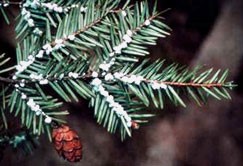 Hemlock Woolly Adelgid (HWA), the Eastern Hemlock’s worst enemy, was discovered in the Skaneateles Lake Watershed in May 2014 in the town of Spafford, NY. Since this insect will eventually kill every Hemlock tree if left unmanaged, the County is preparing a management strategy to preemptively combat this insect before a full-fledged invasion. Eastern Hemlock are considered a “keystone” species in the Northeastern United States, meaning they play a critical ecological role. The dense shade provided by their branches keeps the soil underneath from drying out, creates cool habitat during the summer for plants and foraging animals, and protects the same areas during the winter from snow and wind, again providing habitat and food. They are often found along streams, and the shade they provide cools the water and keeps the streams and their aquatic species healthy. Hemlock Woolly Adelgid (HWA), the Eastern Hemlock’s worst enemy, was discovered in the Skaneateles Lake Watershed in May 2014 in the town of Spafford, NY. Since this insect will eventually kill every Hemlock tree if left unmanaged, the County is preparing a management strategy to preemptively combat this insect before a full-fledged invasion. Eastern Hemlock are considered a “keystone” species in the Northeastern United States, meaning they play a critical ecological role. The dense shade provided by their branches keeps the soil underneath from drying out, creates cool habitat during the summer for plants and foraging animals, and protects the same areas during the winter from snow and wind, again providing habitat and food. They are often found along streams, and the shade they provide cools the water and keeps the streams and their aquatic species healthy.
The destruction of HWA is comparable to that of invasive beetle Emerald Ash Borer (EAB). HWA is an aphid-like beetle that is reddish-brown to black in color, and feeds on Hemlock sap with long feeding tubes until tree needles fall off. The tree then shuts off growth supply to infected branches, leading to its eventual decline and death. Natural predators have been able to allow HWA and Hemlock trees to live cohesively in its native habitat of the Pacific Northwestern U.S. and Asia; however, in the Northeastern U.S. this is not the case. The HWA reproduces asexually in the Northeast, meaning it does not need to wait for a mate to land on the same tree before producing its offspring. This allows the bug to spread to surrounding trees much quicker than in other environments. Another factor that increases the spread of HWA is the fact that their active lifecycle is January-May, when most natural predators are gone.
Without management, the only thing to do is accept the environmental loss and move on. Potential management strategies involve the removal or treatment of trees, or the biological control of HWA using introduced predators. Cornell Cooperative Extension has been working on a biological control species nicknamed Little Larry to combat HWA in the Northeastern U.S. Some of these controls have already been released in Skaneateles, NY in 2014. Luckily, HWA is distinct from EAB in that Hemlock trees already been infected are still eligible for treatment. In many cases, even trees with thinned canopies can be brought back to full help so homeowners have time to assess and act. Hemlock trees do not need to be treated before HWA is detected, as was the case with EAB. There are currently two pesticides being used for HWA in New York through soil drenching, soil injection, and time-release soil tablets.
Onondaga County is exploring management options and determining the threat caused by the Hemlock Woolly Adelgid in our region.
|


 Hemlock Woolly Adelgid (HWA), the Eastern Hemlock’s worst enemy, was discovered in the Skaneateles Lake Watershed in May 2014 in the town of Spafford, NY. Since this insect will eventually kill every Hemlock tree if left unmanaged, the County is preparing a management strategy to preemptively combat this insect before a full-fledged invasion. Eastern Hemlock are considered a “keystone” species in the Northeastern United States, meaning they play a critical ecological role. The dense shade provided by their branches keeps the soil underneath from drying out, creates cool habitat during the summer for plants and foraging animals, and protects the same areas during the winter from snow and wind, again providing habitat and food. They are often found along streams, and the shade they provide cools the water and keeps the streams and their aquatic species healthy.
Hemlock Woolly Adelgid (HWA), the Eastern Hemlock’s worst enemy, was discovered in the Skaneateles Lake Watershed in May 2014 in the town of Spafford, NY. Since this insect will eventually kill every Hemlock tree if left unmanaged, the County is preparing a management strategy to preemptively combat this insect before a full-fledged invasion. Eastern Hemlock are considered a “keystone” species in the Northeastern United States, meaning they play a critical ecological role. The dense shade provided by their branches keeps the soil underneath from drying out, creates cool habitat during the summer for plants and foraging animals, and protects the same areas during the winter from snow and wind, again providing habitat and food. They are often found along streams, and the shade they provide cools the water and keeps the streams and their aquatic species healthy.